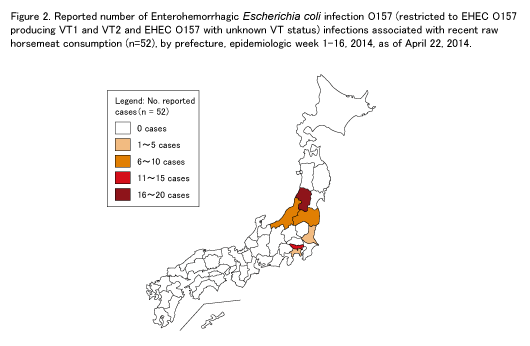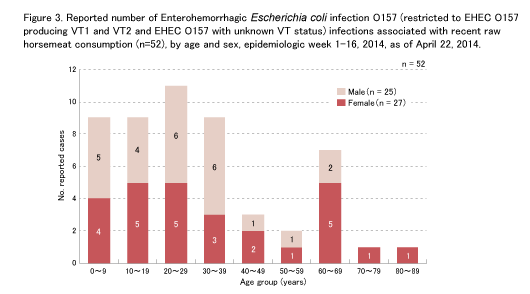|
 
◆ Enterohemorrhagic Escherichia coli infection update, epidemiologic week 1-16, 2014 (as of April 22, 2014)
Enterohemorrhagic Escherichia coli (EHEC) infection is a potentially serious infection that can cause severe complications such as haemolytic uremic syndrome (HUS). Children less than 5 years of age are particularly at risk of HUS and the case-fatality rate among HUS cases may reach 5% 1, 2, 3).
During epidemiologic weeks 1 to 16 (as of April 22, 2014), the number of reported cases (including asymptomatic cases) of EHEC O157 infections (restricted to EHEC O157 producing both verotoxins 1 and 2 [VT1 and VT2] and EHEC O157 with unknown VT status) increased considerably. While 5 or fewer cases per week were reported during weeks 1 to 13, cases rapidly increased from week 14, surpassing levels reported during recent years. Through week 16, there were cumulatively 126 cases reported in 2014 (as of April 22, 2014), which was the second highest number of reported EHEC O157 infections since 2009 for the same time period (102 cases in 2009, 178 cases in 2010, 66 cases in 2011, 66 cases in 2012, and 67 cases in 2013; all restricted to VT1 and VT2-producing EHEC O157 or EHEC O157 with unknown VT status). During the same time period, among the reported cases, there were 3 (2.9%) HUS cases in 2009, 5 (2.8%) HUS cases in 2010, 1 HUS case in 2011 (1.5%), 1 HUS case in 2012 (1.5%), 3 HUS cases in 2013 (4.5%), and 3 HUS cases in 2014 (2.4%) (all restricted to VT1 and VT2-producing EHEC O157 or EHEC O157 with unknown VT status); while a similar proportion of approximately 2% of reported EHEC O157 cases were HUS in 2014, the number of reported HUS cases was second highest following 2010 (along with 2009 and 2013). Among the 126 cases, nearly half (n=52) were cases associated with recent raw horsemeat consumption (figure 1), and among those, one (1.9%) case developed HUS (the 52 cases included those who may not have consumed horsemeat themselves but had close contact with symptomatic cases that had consumed raw horsemeat).
 |
During epidemiologic weeks 1 to 16 (as of April 22, 2014), cases were reported from 22 prefectures. Those with the greatest number of reports came from the Tohoku and Kanto regions; prefectures that reported at least 10 cases were Fukushima (n=34), Tokyo (n=21), Yamagata (n=18), and Niigata (n=10). This geographic distribution was similar for those cases that were associated with recent raw horsemeat consumption, with all cases from Yamagata being such cases: Yamagata (n=18), Tokyo (n=12), Fukushima (n=10), and Niigata (n=9) (figure 2). On April 8, 2014, Fukushima prefecture reported on the adverse health outcomes (abdominal cramps, diarrhoea, bloody stool, and fever) associated with consumption of raw horsemeat, and stated that such cases had occurred in Fukushima, Niigata, and Yamagata prefectures4). Furthermore, according to a report by Fukushima prefecture (dated April 17, 2014), 4 samples of the implicated product tested positive for EHEC O157 VT1 and VT25).
 |
Among the cases associated with recent raw horsemeat consumption, the majority were relatively young, with 11 cases aged 20-29 years and 9 cases each among 0-9 year olds, 10-19 year olds, and 30-39 year olds (figure 3).
With the coming summer months historically associated with an increase in EHEC notifications6), given the already large number of EHEC O157 infection cases reported to date this year, it is imperative to emphasize prevention. This includes not only proper cooking practices (“cook thoroughly”) but also proper hygiene, such as hand-washing, to prevent secondary transmissions. For those with increased risk of HUS, such as young children, caution is especially warranted.
Infectious Disease Surveillance Center,
National Institute of Infectious Diseases
Kunio Kawabata, Munehisa Fukusumi, Yuichiro Yahata, Atsuhiro Kanayama, Yuzo Arima, Takehito Saitoh, Takuri Takahashi, Kazuhiko Kanou, Kazunori Oishi, and Tomimasa Sunagawa
References
1) Takehito Saitoh, Yoshiyuki Sugishita, Teppei Tomioka, Tomoe Shimada, Tomimasa Sunagawa, and Yuki Tada. Hemolytic-uremic syndrome associated with Enterohemorrhagic Escherichia coli infection, 2008. IASR. 2009;30(5):122-123.
https://idsc.niid.go.jp/iasr/30/351/dj3511.html
2) Rangel JM, Sparling PH, Crowe C, Griffin PM, Swerdlow DL. Epidemiology of Escherichia coli O157:H7 Outbreaks, United States, 1982-2002. Emerg Infect Dis. 2005;11(4):603-9.
http://wwwnc.cdc.gov/eid/article/11/4/04-0739_article.htm
3) Pavia AT, Nichols CR, Green DP, Tauxe RV, Mottice S, Greene KD, Wells JG, Siegler RL, Brewer ED, Hannon D, et al. Hemolytic-uremic syndrome during an outbreak of Escherichia coli O157:H7 infections in institutions for mentally retarded persons: clinical and epidemiologic observations. J Pediatr. 1990;116(4):544-51.
4) Fukushima Prefecture. Recall of raw horsemeat intended for consumption. Press release number 3. April 8, 2014.
https://www.pref.fukushima.lg.jp/uploaded/attachment/57694.pdf
5) Fukushima Prefecture. Investigation of a Food Poisoning outbreak by Fukushima Prefecture. Press release number 2. April 17, 2014.
http://www.pref.fukushima.lg.jp/uploaded/attachment/59250.pdf
6) Enterohemorrhagic Escherichia coli infection update, epidemiologic week 29, 2013. IDWR. 2013.
https://www0.niid.go.jp/niid/idsc/idwr/IDWR2013/idwr2013-29.pdf
|
|


